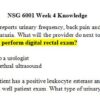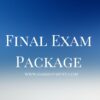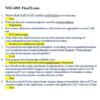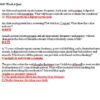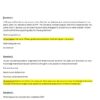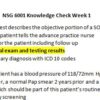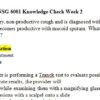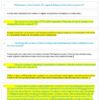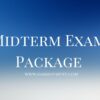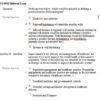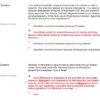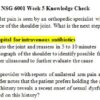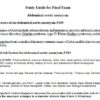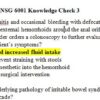Description
NSG 6001 Final Exam 2 – Question and Answers
- What are the two main types of heart failure?
- Maintenance of an Isometric ST segment during exercise is the response of?
- Your mentor says that you should be prepared to know how to determine the maximum heart rate for your patient during the ETT. How is the age-predicted maximum heart rate during an ETT determined?
- Your patient asks you what causes a rupture of an abdominal aortic aneurysm. You know the answer is most often:
- After completion of the exercise stress test, you would measure the ST-segment depression after the J point of the QRS. The J point is located where in relation to the QRS?
- Your preceptor decides to add Doppler Flow studies to the echocardiogram exercise test for a patient with a recent history of a holistic murmur best auscultated at the left steral boarder.
- The patient has no history of cardiac surgeries. He asks you what might be the main advantages of adding Doppler Flow for this particular patient. You know from your readings that there are several reasons to add Doppler Flow and below are listed more than one correct reason. Your best response for this specific case, however, would be that Doppler Flow studies would be of what additive value during the echocardiogram study?
- You receive a report back on the suspected abdominal aortic aneurysm for your patient. It confirms your suspicion of AAA. The report describes the aneurysm as an asymmetric weakness of the entire circumference of the aorta. You know that this form of aneurysm is referred to as what kind of aneurysm?
- You see a 35-year-old male in the office for the first time. He states that he has been diagnosed with recurrent urinary tract infections. You know that urinary tract infections are uncommon among men less than 50 years of age and are considered complicated infections in this age group. On physical examination, the patient is circumcised, and he denies homosexual activities. What other assessment or history question might be most pertinent in managing this patient?
- Your patient has an AAA that you have been watching. It is now progressed to greater than 4.0cm in size. What action should you consider at this juncture in patient management of this condition?
- The goal of self-management is to specifically do what?
- What are the two types of bradycardia recognized by the American Heart Association?
- What criterion does the American Heart Association use to classify relative bradycardia?
- A 47-year old female with general complaints of fatigue and shortness of breath shows up in your clinic as a referral from another nurse practitioner. Several blood tests and chest x-rays have been completed without any diagnosis or outstanding abnormalities. You decide to order an ETT despite the fact that the recent ECG does not show any abnormalities. From the answers below, which would be the best answer to support your decision?
- By standard criteria, how is a positive stress test defined?
- Your patient underwent an exercise stress test for CAD. There is a significant elevation of the ST-segment. What do you need to know about these changes to manage your patient’s care?
- Why would the inability to exercise reduce the specificity of the routine ETT?
- Of the following, which is the best answer when asked for an advantage of echocardiogram exercise testing over thallium stress testing?
- The diagnostic accuracy of stress testing is decrease among women compare to men for what reasons?
- When there is a consequential loss of structural integrity of the abdominal aorta, the resulting issue is what condition?
- What are the most common symptoms caused by tachyarrhythmias?
- Medicare hospital insurance (Part A) is fund through what system?
- Your 60-year old male patient arrives for his appointment. He complains of general malaise and fever over the past several days with low back pain. He also states that he is getting up at night more often to urinate and never feels his bladder is completely empty. What differential diagnosis should you consider in this patient?
- What do you know regarding ischemia that is confine to only the posterior and or lateral segments of the left ventricle?
- Your patient was recently treat for tachycardia and now has a normalized heart rate and rhythm. On examination, you notice a new S3 heart sound. What condition are you concerned with at this time based on this new finding? (NSG 6001 Final Exam)
- Your patient is morbidly obese and cannot sit on a bicycle or walk a treadmill. She also has marked and severe emphysema. You need to make an assessment of the risk of significant CAD and your patient’s family says that their relative had their diagnosis based on an ultrasound echocardiography. What facts would influence your decision regarding the family request for echo assessment?
- What happens to coronary flow related to CAD?
- The reason for the increase in chlamydia diagnosis is thought to be relate to what event?
- In a person with diagnosed abdominal aortic aneurysm, which symptoms might indicate impending rupture?
- You see a 75-year old female in your clinic today complaining of urinary incontinence. She is otherwise healthy based upon her last visit. She states that her mother told her this would happen someday because it happens to every woman at some age. What would you tell this patient?
- Changes in Medicare are a method the government uses to make changes to reimbursement schedules for healthcare. Currently, Medicare reimburses nurse practitioners for all services, even those deemed to be exclusive to nursing?
- A 35-year-old female arrives at your clinic. She has had diabetes and peripheral artery disease for the past 5 years. You decide to obtain an ETT. The insurance company argues that this is inappropriate. You justify the ETT because you are planning secondary strategies to prevent future heart disease. Where could one find the supporting data for these guidelines?
- What is considere the first-line initial approach to test for CAD?
- The majority of all strokes are non-ischemic. Is this statement true or false? (NSG 6001 Final Exam)
- BPH is not a risk factor for Prostate cancer. Is this statement true or false?
- In women, you need to know the limitations of certain tests for CAD. For example, single-photon emissions CT imaging, while an acceptable test for most men and some women, is technically limit in women for two reasons. From the following, choose the best possible answer.
- When a murmur is first heard, it is important to determine if it is due to a pathological condition or benign. For an experienced practitioner, it is always easy to determine the cause of a murmur merely by listening to the sound. Is this statement true or false?
- What sexually transmitted disease is most widespread in the USA today?
- You are considering adding an adjunctive form of testing to detect wall motion abnormalities during the ETT. You select Echocardiography as the added testing. You-choose this test because you know that echocardiography does what when added to a standard ETT?
- You tell a patient that he has a murmur. He says he has been told this before but wonders what causes the unique sounds of a murmur. Which of the following would be your best option?
- Your patient has uncomplicated pyelonephritis. In deciding your recommended treatment, you consider the most common pathogenic reason for this diagnosis. What pathogen accounts for the majority of pyelonephritis? (NSG 6001 Final Exam)
- What purpose does the principle of fidelity serve in the provider/patient relationship?
- Your 56-year old patient presents with bradycardia with a rate of 55 and first-degree AV block. The patient is hemodynamically stable and is not experiencing any syncope or chest pain. History includes previous myocardial infarction. Home medications include beta-blockers, daily aspirin. Lab work is non-significant for electrolyte imbalance. You decided to treat this patient for arrhythmia to prevent future destabilization. From the choices below, which might be the appropriate first measure to consider?
- What is the treatment of choice for uncomplicated community-acquired cystitis?
- What is the most common cause of systolic heart failure?
- Chronic, non-communicable diseases account for disproportionate costs to the healthcare system. According to the World Health Organization, what percent of preventable deaths and disabilities occur in the Americas related to chronic non-communicable diseases?
- Skin cancer is the most common malignant neoplasm in males in the US. What is the second leading cause of cancer deaths in men greater than 50 years of age?
- All patients, even is asymptomatic, require risk stratification according to the Framingham risk score. At present, ACC/AHA guidelines, however, do not normally support stress tests for asymptomatic patients without addiitonal justification. From the list below, what could be use to justify a ETT in an asymptomatic patient?
- Eligibility for Medicaid includes the following: (NSG 6001 Final Exam)
- What three conditions definitely alter the results of echocardiography in determining CAD?
- We all know that collaboration is integral to becoming a successful nurse practitioner. Among collaborations, however, only one can be considere as the most important. While each example below is important, which is the most important collaboration? The one that occurs:
- Tachyarrhythmias cause a drop in common blood pressure, cardiac output, syncope, shortness of breath, and chest pain. What phenomenon most often occurs during these arrhythmias to cause these symptoms?
- Of the answers below, which would be included in defining a positive Exercise Echocardiogram?
- The sensitivity of a routine ETT is effort dependent. What physiological changes occur during effort in the routine ETT?
- For women with known CAD and diabetes, which is most appropriate to assess CAD risk?
- On the echocardiography, during the ETT you notice the following change: abnormal left ventricular ejection fraction. What do these changes suggest related to this patient?
- Your patient is newly diagnose with persistent Atria Fibrillation. You consider electrocardioversion. Before undergoing this procedure you should order the following examination to assess thrombus risk.
- Population disease management is a term use to describe: (NSG 6001 Final Exam)
- At what point is the elective repair of an abdominal aortic aneurysm (AAA) for a healthy patient considered appropriate?
- Your practice partner just ordered an exercise echocardiography 2DE for a patient with suspected cardiovascular risk. This patient has known resting wall motion abnormalities. Why would this not be the best test to assess this patient’s cardiac risk?
- Medicare covers inpatient hospital services under which part of the Medicare insurance?
- Check out our latest courses on NURS 6551.


